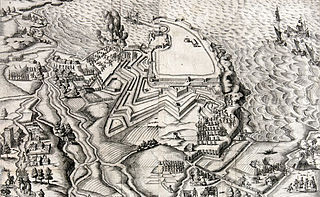
Montauban is a commune in the southern French department of Tarn-et-Garonne. It is the capital of the department and lies 50 kilometres (31 mi) north of Toulouse. Montauban is the most populated town in Tarn-et-Garonne, and the sixth most populated of Occitanie behind Toulouse, Montpellier, Nîmes, Perpignan and Béziers. In 2019, there were 61,372 inhabitants, called Montalbanais. The town has been classified Ville d’art et d’histoire since 2015.

Louis XIII was King of France from 1610 until his death in 1643 and King of Navarre from 1610 to 1620, when the crown of Navarre was merged with the French crown.

The Siege of La Rochelle was a result of a war between the French royal forces of Louis XIII of France and the Huguenots of La Rochelle in 1627–1628. The siege marked the height of the struggle between the Catholics and the Protestants in France, and ended with a complete victory for King Louis XIII and the Catholics.

Chomérac is a commune in the Ardèche department in southern France.

Privas is a city located in France, in the department of Ardèche.

The Anglo-French War was a military conflict fought between the Kingdom of France and the Kingdom of England between 1627 and 1629. It mainly involved actions at sea. The centrepiece of the conflict was the siege of La Rochelle (1627–28), in which the English Crown supported the French Huguenots in their fight against the French royal forces of Louis XIII of France. La Rochelle had become the stronghold of the French Huguenots, under its own governance. It was the centre of Huguenot seapower and the strongest centre of resistance against the central government. The English also launched a campaign against France's new colony in North America which led to the capture of Quebec.

The Huguenot rebellions, sometimes called the Rohan Wars after the Huguenot leader Henri de Rohan, were a series of rebellions of the 1620s in which French Calvinist Protestants (Huguenots), mainly located in southwestern France, revolted against royal authority. The uprising occurred a decade after the death of Henry IV who, himself originally a Huguenot before converting to Catholicism, had protected Protestants through the Edict of Nantes. His successor Louis XIII, under the regency of his Italian Catholic mother Marie de' Medici, became more intolerant of Protestantism. The Huguenots responded by establishing independent political and military structures, establishing diplomatic contacts with foreign powers, and openly revolting against central power. The Huguenot rebellions came after two decades of internal peace under Henry IV, following the intermittent French Wars of Religion of 1562–1598.

The siege of Saint-Jean-d'Angély was a siege, accomplished by the young French king Louis XIII in 1621, against the Protestant stronghold of Saint-Jean-d'Angély led by Rohan's brother Benjamin de Rohan, duc de Soubise. Saint-Jean-d'Angély was a strategic city controlling the approach to the Huguenot stronghold of La Rochelle.

The siege of Montauban was a siege conducted by the young French king Louis XIII from August to November 1621, against the Protestant stronghold of Montauban. This siege followed the siege of Saint-Jean-d'Angély, in which Louis XIII had succeeded against Rohan's brother Benjamin de Rohan, duc de Soubise.

The Blockade of La Rochelle took place in 1621-1622 during the repression of the Huguenot rebellion by the French king Louis XIII.

The Capture of Saumur was the military investment of the Huguenot city of Saumur accomplished by the young French king Louis XIII on 11 May 1621, following the outbreak of the Huguenot rebellions. Although the Huguenot city was faithful to the king, Louis XIII nevertheless wished to affirm control over it. The Governor of the city Duplessy-Mornay was tricked out of his command of Saumur and the city was invested.

The siege of Royan was a siege accomplished by the young French king Louis XIII in 1622, against the Protestant stronghold of Royan. This siege followed the siege of Montauban, in which Louis XIII had failed against the Huguenot city.

The Nègrepelisse massacre was a massacre committed on 10 and 11 June 1622 by the French Royal Army of the King Louis XIII in the Protestant stronghold of Nègrepelisse during the Huguenot rebellions. The taking of the town followed Louis's unsuccessful siege of Montauban.

The Treaty of Compiègne, signed on 10 June 1624, was a mutual defence alliance between the Kingdom of France and the Dutch Republic, for an initial period of three years.

The siege of Alès was undertaken by Louis XIII of France, and the city captured on 17 June 1629.

The siege of Montpellier was a siege of the Huguenot city of Montpellier by the Catholic forces of Louis XIII of France, from August to October 1622. It was part of the Huguenot rebellions.

The Surrender of Montauban occurred on 21 August 1629, when the Huguenot city of Montauban surrendered to the Catholic troops of the French king Louis XIII under the direction of Richelieu.
Events from the year 1629 in France.

Blaise François Pagan (1603–1665) was a French soldier and military engineer who served in the army of Louis XIII. His military career ended in 1642 when he lost his sight and in 1645, he published Les Fortifications; this became the dominant text of its era on military fortifications and significantly influenced Sébastien Le Prestre de Vauban.
Events from the year 1621 in France.




















